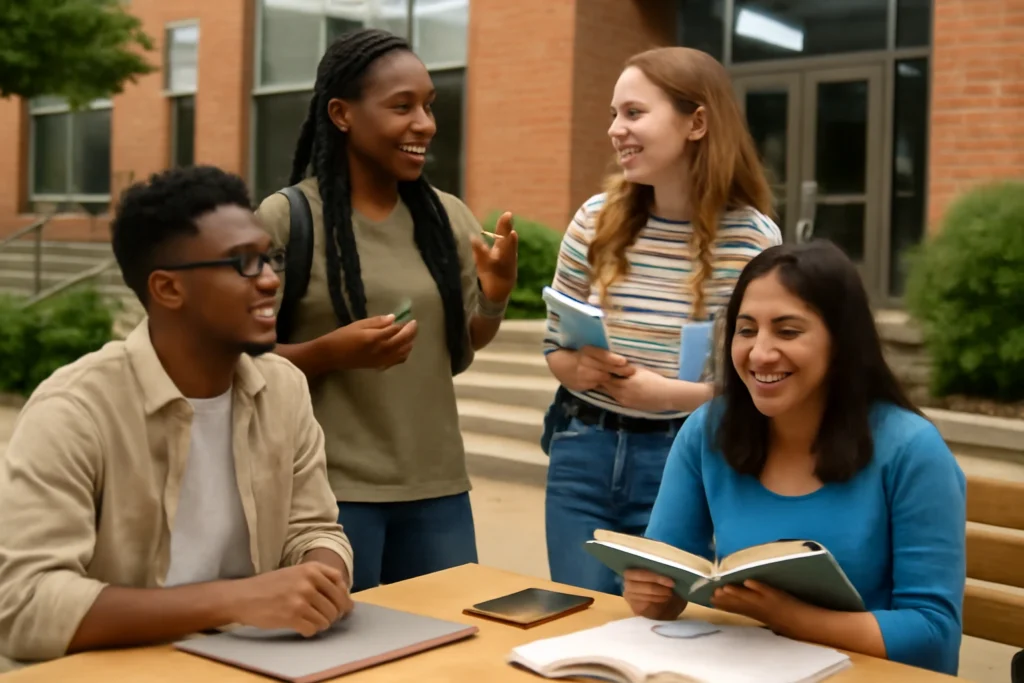Many students say they barely have time for cultural activities during the term, and things soon fall apart because of it.
In general, students who cut culture out of their lives often feel more stressed, earn lower grades, and struggle to connect with their campus community. When academic pressure eats up their schedule, cultural learning is the first thing they sacrifice.
But you don’t have to choose between academia and culture, because the best students can find ways to balance cultural experiences with their academic work.
That’s why in this article, you’ll learn why this balance is so important, what gets in your way, and four practical strategies you can start using this week.
So, let’s see how to balance academics and culture without feeling overwhelmed.
What Is Cultural Education in the Student Context?
Cultural education means learning about diverse traditions, perspectives, and values alongside your academic studies to develop as a whole person. It works by blending it into everything you’re already doing at university.
When you’re sitting in a sociology lecture about inequality, that’s academic learning. But when you volunteer at a community centre and see how those theories play out with real families, that’s cultural education in action.
These two together make you more capable than either one alone.
College Student Development Overlooks Cultural Education
Even though cultural education gets you better outcomes, most college students struggle to balance coursework with cultural learning. Some of these problems may come from how you manage your time, but others come from how universities set things up in the first place.

So, let’s take a look at what’s actually getting in your way.
Time Constraints and Competing Priorities
As a college student, you have to juggle coursework, jobs, and cultural development opportunities with limited hours. Maybe add in part-time work, family responsibilities, and trying to maintain some sort of social life.
Even if you’d love to make it to the Diwali celebration or join the international film club, the due dates for those three essays and the looming exams tend to push everything else down your priority list.
On top of that, student services often operate separately from academic departments on university campuses. So even when cultural events happen, you don’t hear about them, or they clash with your lectures.
Institutional Barriers to Integration
Most universities unintentionally make it harder for you to blend academics with cultural learning. It’s because they treat cultural activities like optional extras instead of part of your actual education.
Faculty and student affairs departments also rarely collaborate on whole-person development. This creates a weird split where your academic life and cultural opportunities exist in parallel universes.
That’s why limited access to guidance makes finding cultural resources difficult for most students. Nobody sits you down in the first year and explains what’s available or how to fit it into your schedule.
How Cultural Education Strengthens Student Development
Blending cultural education with coursework gives you practical advantages that textbooks alone can’t provide. And we’re not talking about vague “personal growth” stuff here. These are concrete benefits that show up in your grades, friendships, and job prospects.
So, let’s try to understand how cultural education strengthens a student’s overall growth.
How Cultural Learning Shapes Cognitive Development
Cultural learning actually rewires how you think and solve problems. Because when you engage with people from different backgrounds, your brain has to work harder, and can’t rely on assumptions or shortcuts anymore.
That’s why exposure to diverse perspectives improves intellectual development during college years. Eventually, you’ll start noticing patterns you missed before, and learn to analyse complex ideas through multicultural classroom experiences.

Cultural Awareness and Academic Success
Students with strong cultural competence achieve higher grades and graduate at better rates than their peers. When you understand different viewpoints, your essays become easier to write, group projects run smoothly, and you can explain ideas to people who think differently from you. Even your lectures will start to feel relevant instead of abstract.
In fact, cultural competence predicts better student success rates in higher education settings, and universities know this very well (even if they don’t always act on it).
Improved Peer Relationships and Social Skills
Cultural engagement makes you better at reading people and building genuine connections across differences. You end up with friends who think differently and challenge your assumptions.
You’ll get to practice communication and empathy through diverse classroom and community interactions. As a result, identity development accelerates when you connect with peers from different backgrounds.
Stronger Mental Health and Resilience
Students involved in cultural activities report much less stress than those focused solely on academics. That’s because appropriate support from culturally aware peers reduces isolation during college years.
And when you feel like you belong somewhere, stress doesn’t hit as hard.
Better Preparation for Global Careers
Multicultural experience is now the fastest route to standing out in competitive job markets. Employers worldwide prioritise graduates with strong cultural competence. They want people who can work with teams spread across different countries.
Students who develop multicultural skills show greater adaptability in graduate programmes worldwide. Real-world practice with diverse teams prepares students for modern workplace challenges.
Now that you know the benefits, here are four practical ways you can start today.
Blending Experiential Learning With Peer Support
You don’t need to change your entire schedule or drop modules. Just making some small shifts in how you approach your existing commitments can make cultural learning part of your regular routine.

Take a look at these strategies:
- Using Experiential Learning Opportunities: You could read 50 pages about community organising, or you could spend three hours helping a local refugee centre. This way, internships and study abroad programmes can teach you more (and you’ll actually remember it next month).
- Building Peer Support Networks: When you study with people from different backgrounds, you get to prepare for exams and learn how others think at the same time. Student organisations that are focused on identity development create safe spaces for personal growth. And regular interaction with diverse peers builds self-authorship and stronger personal development.
- Leveraging Campus Cultural Resources: Your university already pays for cultural resources that most students never discover or use. University libraries, museums, and cultural centres give free resources for active student learning. The trick is finding out what’s available.
- Managing International and First-Generation Student Challenges: First-generation students benefit from mentorship programmes that explain unspoken university culture and norms. International students need appropriate support in balancing their home culture with the new school environment. So building cultural competence helps all students feel connected despite their different starting points.
Blend these practices into your routine, and they’ll stop feeling like extra tasks. They’ll simply become part of how you learn, grow, and stay balanced through the term.
Finding a Balance That Works for You
When you try to balance your academics and culture, it doesn’t have to be perfect time management or adding more to your plate. You blend cultural learning into what you’re already doing.
Maybe study with people from different backgrounds, pick assignments that let you explore cultural topics, or use campus resources you’re already paying for through tuition. The students who do this end up getting better grades. They also feel less stressed, make stronger friendships, and land better jobs after graduation.
Now that you’ve got the roadmap from Juergens Meyer, the hardest part is just starting. So pick one strategy from this article and try it before next week.





